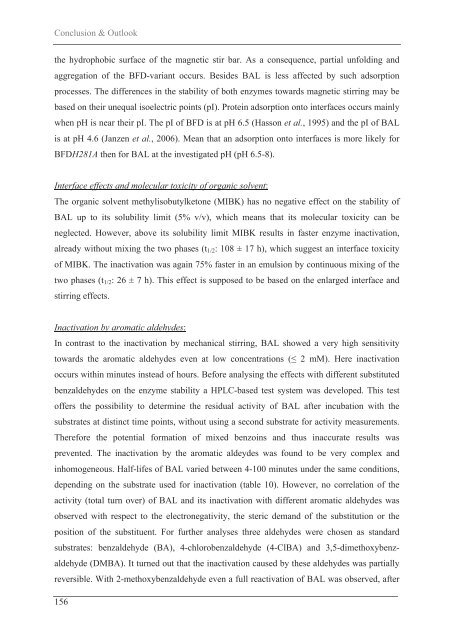Helmholtz-Gemeinschaft
Einflussfaktoren auf die Stabilität und Aktivität der ... - JuSER
Einflussfaktoren auf die Stabilität und Aktivität der ... - JuSER
Create successful ePaper yourself
Turn your PDF publications into a flip-book with our unique Google optimized e-Paper software.
Conclusion & Outlook<br />
the hydrophobic surface of the magnetic stir bar. As a consequence, partial unfolding and<br />
aggregation of the BFD-variant occurs. Besides BAL is less affected by such adsorption<br />
processes. The differences in the stability of both enzymes towards magnetic stirring may be<br />
based on their unequal isoelectric points (pI). Protein adsorption onto interfaces occurs mainly<br />
when pH is near their pI. The pI of BFD is at pH 6.5 (Hasson et al., 1995) and the pI of BAL<br />
is at pH 4.6 (Janzen et al., 2006). Mean that an adsorption onto interfaces is more likely for<br />
BFDH281A then for BAL at the investigated pH (pH 6.5-8).<br />
Interface effects and molecular toxicity of organic solvent:<br />
The organic solvent methylisobutylketone (MIBK) has no negative effect on the stability of<br />
BAL up to its solubility limit (5% v/v), which means that its molecular toxicity can be<br />
neglected. However, above its solubility limit MIBK results in faster enzyme inactivation,<br />
already without mixing the two phases (t 1/2 : 108 ± 17 h), which suggest an interface toxicity<br />
of MIBK. The inactivation was again 75% faster in an emulsion by continuous mixing of the<br />
two phases (t 1/2 : 26 ± 7 h). This effect is supposed to be based on the enlarged interface and<br />
stirring effects.<br />
Inactivation by aromatic aldehydes:<br />
In contrast to the inactivation by mechanical stirring, BAL showed a very high sensitivity<br />
towards the aromatic aldehydes even at low concentrations (≤ 2 mM). Here inactivation<br />
occurs within minutes instead of hours. Before analysing the effects with different substituted<br />
benzaldehydes on the enzyme stability a HPLC-based test system was developed. This test<br />
offers the possibility to determine the residual activity of BAL after incubation with the<br />
substrates at distinct time points, without using a second substrate for activity measurements.<br />
Therefore the potential formation of mixed benzoins and thus inaccurate results was<br />
prevented. The inactivation by the aromatic aldeydes was found to be very complex and<br />
inhomogeneous. Half-lifes of BAL varied between 4-100 minutes under the same conditions,<br />
depending on the substrate used for inactivation (table 10). However, no correlation of the<br />
activity (total turn over) of BAL and its inactivation with different aromatic aldehydes was<br />
observed with respect to the electronegativity, the steric demand of the substitution or the<br />
position of the substituent. For further analyses three aldehydes were chosen as standard<br />
substrates: benzaldehyde (BA), 4-chlorobenzaldehyde (4-ClBA) and 3,5-dimethoxybenzaldehyde<br />
(DMBA). It turned out that the inactivation caused by these aldehydes was partially<br />
reversible. With 2-methoxybenzaldehyde even a full reactivation of BAL was observed, after<br />
156















